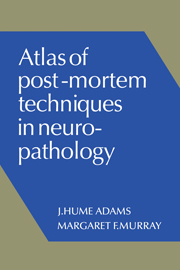4 - The Spinal Cord
Published online by Cambridge University Press: 21 May 2010
Summary
The spinal cord should be examined routinely in every post-mortem examination on a patient with a disorder of the central nervous system. This may, on occasion, appear to be an unnecessary labour but even in a patient thought to have died as a result of a severe head injury, removal of the spinal cord may disclose that there has been an unsuspected fracture/dislocation of the cervical spine; and in a patient known to have a malignant brain tumour, examination of the spinal cord may disclose that diffuse tumour or seedlings in the spinal subarachnoid space have materially contributed to the clinical picture. And there are numerous metabolic derangements including disseminated systemic malignant disease where long tract degeneration in the spinal cord, particularly in the posterior columns, has been the principal source of neurological dysfunction. If the cord is not removed precise clinico-pathological correlations can never be established in such cases.
There is inevitably a certain reluctance on the part of the pathologist and the mortuary attendant to remove the cord because of the extra time and labour involved. In cases of particular interest, the best technique is to remove the entire vertebral column so that a careful dissection can be undertaken after appropriate preliminary fixation but, using the anterior approach illustrated here, removal of the spinal cord and posterior root ganglia can with experience be accomplished in little more than 10–15 minutes.
- Type
- Chapter
- Information
- Atlas of Post-Mortem Techniques in Neuropathology , pp. 67 - 81Publisher: Cambridge University PressPrint publication year: 1982



